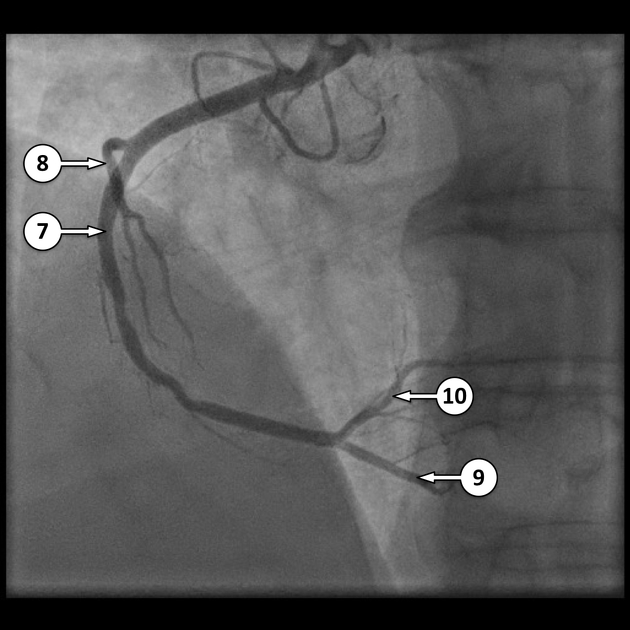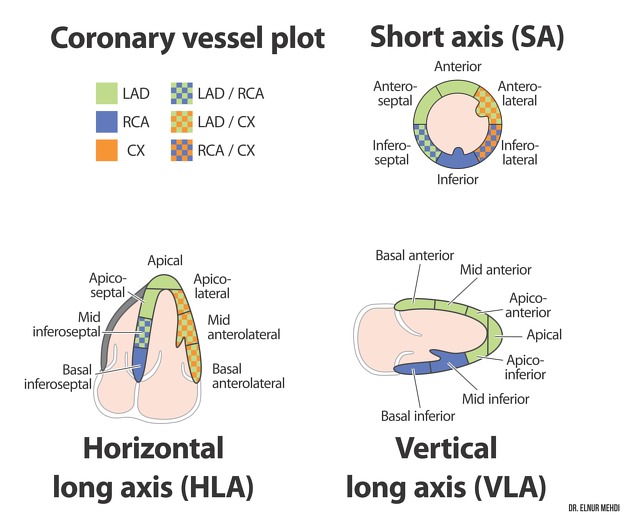The right coronary artery (RCA) is one of the two main coronary arteries that supply the heart with oxygenated blood.
On this page:
Gross anatomy
Origin
The right coronary artery arises from its ostium in the right sinus of Valsalva, found between the aortic valve annulus and the sinotubular junction.
Course
After a sharply horizontal egress from the aorta, the proximal segment of the right coronary artery courses superiorly and rightward, posterior to the pulmonary trunk and underneath the right atrial appendage. The mid-right coronary artery curves in an inferior direction in the plane of the atrioventricular groove. The distal segment curves toward the cardiac crux as it travels along the posterior interventricular groove, with a subsequent bifurcation forming the posterior left ventricular branch and the posterior descending artery (PDA); the formation of the latter defines coronary arterial dominance 5.
when the right coronary artery gives rise to the posterior descending artery, this defines a right dominant circulation (70% population)
contribution from both the right coronary artery and left circumflex artery defines a co-dominant circulation (20%)
the least common (10%) variant is a left dominant circulation in which the left circumflex artery continues as the PDA
The three segments of the right coronary artery are:
proximal segment: from the right coronary artery origin to halfway along the acute margin of the heart
mid segment: from halfway along the acute margin to the acute angle of the heart, where it courses along the posterior AV groove
distal segment: from the acute angle to the apex
Branches
-
proximal right coronary artery
conus artery (in 60%)
-
atrial branches
sinoatrial nodal artery (in 60%)
-
mid right coronary artery
right ventricular branches
acute marginal arteries (designated AM1, 2, etc.)
-
distal right coronary artery
posterior descending artery (PDA) (which defines a right dominant circulation)
posterior left ventricular branches (PLV, PLB or PLA)
Supply
-
conus branch: right ventricular outflow tract
descending septal artery: infundibular septum 5
-
atrial branches: right and left atria, interatrial septum
sinoatrial nodal artery: sinoatrial (SA) node
-
right ventricular branches
acute and RV marginal branches: right ventricular free wall
-
posterior descending artery: right ventricular inferior wall
posterior septal perforators: posterior one-third of the interventricular septum
posterior left ventricular branches: the inferior wall of the left ventricle
Coronary dominance
Most hearts are right dominant, in which the PDA is supplied by the RCA. However up to 20% of hearts may be left dominant, in which the PDA is supplied by the LAD or LCx or codominant, whereby a single or duplicated PDA is supplied by branches of both the RCA and LAD/LCx.
For a more in-depth discussion of coronary dominance, see the article coronary arterial dominance.
Variant anatomy
Variations in origin
from the aorta at or above the sinotubular junction
from the left coronary sinus or left coronary artery where the proximal RCA takes a 'malignant' interarterial course in which the vessel is prone to extrinsic compression
in up to 50% of cases, there are separate ostia for the RCA and conus artery 2 from the sinus or aorta
anomalous right coronary artery from the pulmonary artery (ARCAPA)
Variations in branching
PDA and PLV as terminal branches
PDA as the only terminal branch (in which the PLV is supplied by the LCx)
terminates as an acute marginal branch (in left dominant circulations)
-
uncommon proximal branch which communicates with either the left circumflex artery or the distal right coronary artery near the crux
-
anastomotic conduit between the conus artery and the left coronary circulation
Variations in course
interarterial course due to an aberrant origin
Radiographic features
Coronary angiography
-
left anterior oblique (40 degrees) views
-
the right coronary ostium, proximal, and mid-right coronary artery are well delineated
the long axis of the posterior descending artery is roughly parallel to the x-ray beam and will be foreshortened
favorable anatomy for cannulation of the RCA ostium
-
cranial angulation (25 degrees) permits superior visualization of the distal RCA
facilitates evaluation of the bifurcation into the posterior LV branch and PDA
-
-
right anterior oblique (30 degrees) views
-
full length of the PDA becomes visible
septal perforators also conspicuous projecting vertically
favorable to evaluate mid-RCA and branches to the RV
-












 Unable to process the form. Check for errors and try again.
Unable to process the form. Check for errors and try again.